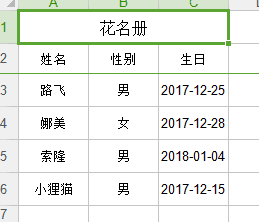excel导入导出
【springboot+easypoi】一行代码搞定excel导入导出
- 开发中经常会遇到excel的处理,导入导出解析等等,java中比较流行的用poi,但是每次都要写大段工具类来搞定这事儿,此处推荐一个别人造好的轮子【easypoi】,下面介绍下“轮子”的使用。
pom引入
- 不再需要其他jar
<dependency>
<groupId>cn.afterturngroupId>
<artifactId>easypoi-baseartifactId>
<version>3.0.3version>
dependency>
<dependency>
<groupId>cn.afterturngroupId>
<artifactId>easypoi-webartifactId>
<version>3.0.3version>
dependency>
<dependency>
<groupId>cn.afterturngroupId>
<artifactId>easypoi-annotationartifactId>
<version>3.0.3version>
dependency>
编写实体类
- 此处注意必须要有空构造函数,否则会报错“对象创建错误”
- 关于注解@Excel,其他还有@ExcelCollection,@ExcelEntity ,@ExcelIgnore,@ExcelTarget等,此处我们用不到,可以去官方查看更多
| 属性 | 类型 | 类型 | 说明 |
|---|---|---|---|
| name | String | null | 列名 |
| needMerge | boolean | fasle | 纵向合并单元格 |
| orderNum | String | "0" | 列的排序,支持name_id |
| replace | String[] | {} | 值得替换 导出是{a_id,b_id} 导入反过来 |
| savePath | String | "upload" | 导入文件保存路径 |
| type | int | 1 | 导出类型 1 是文本 2 是图片,3 是函数,10 是数字 默认是文本 |
| width | double | 10 | 列宽 |
| height | double | 10 | 列高,后期打算统一使用@ExcelTarget的height,这个会被废弃,注意 |
| isStatistics | boolean | fasle | 自动统计数据,在追加一行统计,把所有数据都和输出这个处理会吞没异常,请注意这一点 |
| isHyperlink | boolean | false | 超链接,如果是需要实现接口返回对象 |
| isImportField | boolean | true | 校验字段,看看这个字段是不是导入的Excel中有,如果没有说明是错误的Excel,读取失败,支持name_id |
| exportFormat | String | "" | 导出的时间格式,以这个是否为空来判断是否需要格式化日期 |
| importFormat | String | "" | 导入的时间格式,以这个是否为空来判断是否需要格式化日期 |
| format | String | "" | 时间格式,相当于同时设置了exportFormat 和 importFormat |
| databaseFormat | String | "yyyyMMddHHmmss" | 导出时间设置,如果字段是Date类型则不需要设置 数据库如果是string 类型,这个需要设置这个数据库格式,用以转换时间格式输出 |
| numFormat | String | "" | 数字格式化,参数是Pattern,使用的对象是DecimalFormat |
| imageType | int | 1 | 导出类型 1 从file读取 2 是从数据库中读取 默认是文件 同样导入也是一样的 |
| suffix | String | "" | 文字后缀,如% 90 变成90% |
| isWrap | boolean | true | 是否换行 即支持\n |
| mergeRely | int[] | {} | 合并单元格依赖关系,比如第二列合并是基于第一列 则{1}就可以了 |
| mergeVertical | boolean | fasle | 纵向合并内容相同的单元格 |
import cn.afterturn.easypoi.excel.annotation.Excel;
import java.util.Date;
public class Person {
@Excel(name = "姓名", orderNum = "0")
private String name;
@Excel(name = "性别", replace = {"男_1", "女_2"}, orderNum = "1")
private String sex;
@Excel(name = "生日", exportFormat = "yyyy-MM-dd", orderNum = "2")
private Date birthday;
public Person(String name, String sex, Date birthday) {
this.name = name;
this.sex = sex;
this.birthday = birthday;
}
public String getName() {
return name;
}
public void setName(String name) {
this.name = name;
}
public String getSex() {
return sex;
}
public void setSex(String sex) {
this.sex = sex;
}
public Date getBirthday() {
return birthday;
}
public void setBirthday(Date birthday) {
this.birthday = birthday;
}
}
导入导出公用方法
public static void exportExcel(List list, String title, String sheetName, Class pojoClass,String fileName,boolean isCreateHeader, HttpServletResponse response){
ExportParams exportParams = new ExportParams(title, sheetName);
exportParams.setCreateHeadRows(isCreateHeader);
defaultExport(list, pojoClass, fileName, response, exportParams);
}
public static void exportExcel(List list, String title, String sheetName, Class pojoClass,String fileName, HttpServletResponse response){
defaultExport(list, pojoClass, fileName, response, new ExportParams(title, sheetName));
}
public static void exportExcel(List> list, String fileName, HttpServletResponse response) {
defaultExport(list, fileName, response);
}
private static void defaultExport(List list, Class pojoClass, String fileName, HttpServletResponse response, ExportParams exportParams) {
Workbook workbook = ExcelExportUtil.exportExcel(exportParams,pojoClass,list);
if (workbook != null);
downLoadExcel(fileName, response, workbook);
}
private static void downLoadExcel(String fileName, HttpServletResponse response, Workbook workbook) {
try {
response.setCharacterEncoding("UTF-8");
response.setHeader("content-Type", "application/vnd.ms-excel");
response.setHeader("Content-Disposition",
"attachment;filename=" + URLEncoder.encode(fileName, "UTF-8"));
workbook.write(response.getOutputStream());
} catch (IOException e) {
throw new NormalException(e.getMessage());
}
}
private static void defaultExport(List> list, String fileName, HttpServletResponse response) {
Workbook workbook = ExcelExportUtil.exportExcel(list, ExcelType.HSSF);
if (workbook != null);
downLoadExcel(fileName, response, workbook);
}
public static List importExcel(String filePath,Integer titleRows,Integer headerRows, Class pojoClass) {
if (StringUtils.isBlank(filePath)){
return null;
}
ImportParams params = new ImportParams();
params.setTitleRows(titleRows);
params.setHeadRows(headerRows);
List list = null;
try {
list = ExcelImportUtil.importExcel(new File(filePath), pojoClass, params);
}catch (NoSuchElementException e){
throw new NormalException("模板不能为空");
} catch (Exception e) {
e.printStackTrace();
throw new NormalException(e.getMessage());
}
return list;
}
public static List importExcel(MultipartFile file, Integer titleRows, Integer headerRows, Class pojoClass) {
if (file == null){
return null;
}
ImportParams params = new ImportParams();
params.setTitleRows(titleRows);
params.setHeadRows(headerRows);
List list = null;
try {
list = ExcelImportUtil.importExcel(file.getInputStream(), pojoClass, params);
}catch (NoSuchElementException e){
throw new NormalException("excel文件不能为空");
} catch (Exception e) {
throw new NormalException(e.getMessage());
}
return list;
}
对的,没看错,这就可以导出导入了,看起来代码挺多,其实是提供了多个导入导出方法而已
测试
@RequestMapping("export")
public void export(HttpServletResponse response){
//模拟从数据库获取需要导出的数据
List personList = new ArrayList<>();
Person person1 = new Person("路飞","1",new Date());
Person person2 = new Person("娜美","2", DateUtils.addDate(new Date(),3));
Person person3 = new Person("索隆","1", DateUtils.addDate(new Date(),10));
Person person4 = new Person("小狸猫","1", DateUtils.addDate(new Date(),-10));
personList.add(person1);
personList.add(person2);
personList.add(person3);
personList.add(person4);
//导出操作
FileUtil.exportExcel(personList,"花名册","草帽一伙",Person.class,"海贼王.xls",response);
}
@RequestMapping("importExcel")
public void importExcel(){
String filePath = "F:\\海贼王.xls";
//解析excel,
List personList = FileUtil.importExcel(filePath,1,1,Person.class);
//也可以使用MultipartFile,使用 FileUtil.importExcel(MultipartFile file, Integer titleRows, Integer headerRows, Class pojoClass)导入
System.out.println("导入数据一共【"+personList.size()+"】行");
//TODO 保存数据库
}
导出结果
导出结果
测试导入
导出结果再添加一行,执行,输出导入数据行数

